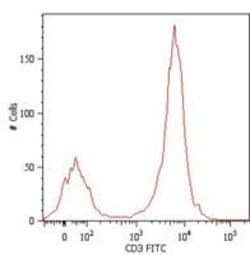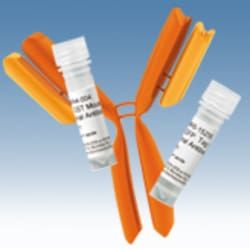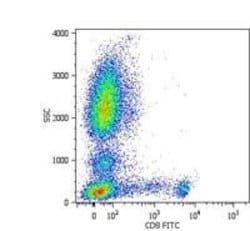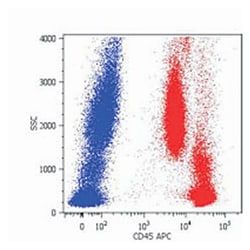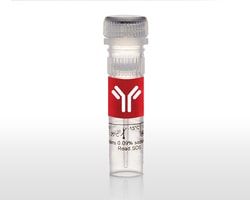KLRB1 Monoclonal Antibody (1C10), Invitrogen™
Manufacturer: Thermo Scientific
Select a Size
| Pack Size | SKU | Availability | Price |
|---|---|---|---|
| Each of 1 | 01-674-341-Each-of-1 | In Stock | ₹ 47,481.50 |
01-674-341 - Each of 1
In Stock
Quantity
1
Base Price: ₹ 47,481.50
GST (18%): ₹ 8,546.67
Total Price: ₹ 56,028.17
Antigen
KLRB1
Classification
Monoclonal
Concentration
0.5 mg/mL
Formulation
PBS with 0.08% sodium azide
Gene Accession No.
P27811, P27812, Q0ZUP1
Gene Symbols
Klrb1, Klrb1a, Klrb1b
Immunogen
Lymphokine-activated killer Cells.
Quantity
100 μg
Primary or Secondary
Primary
Target Species
Mouse
Product Type
Antibody
Isotype
IgG
Applications
Flow Cytometry, Immunoprecipitation, Western Blot
Clone
1C10
Conjugate
Unconjugated
Gene
Klrb1a
Gene Alias
4930431A04Rik; Antigen 3.2.3; CD161; CD161 antigen-like family member A; CD161 antigen-like family member B; CD161a; CD161b; CLEC5B; C-type lectin domain family 5 member B; EMBL:AAQ11375.1}; Gm4696; HNKR-P1a; Immunoreceptor NKR-P1E; immunoreceptor NKR-P1G; inhibitory receptor NKR-P1B; killer cell lectin like receptor B1; killer cell lectin-like receptor subfamily A member 1 complex; killer cell lectin-like receptor subfamily B member 1; killer cell lectin-like receptor subfamily B member 1 complex; killer cell lectin-like receptor subfamily B member 1A; killer cell lectin-like receptor subfamily B member 1B; killer cell lectin-like receptor subfamily B member 1B allele A; Killer cell lectin-like receptor subfamily B member 1B allele B; killer cell lectin-like receptor subfamily B member 1B allele C; killer cell lectin-like receptor subfamily B member 1D; killer cell lectin-like receptor subfamily B member 1F; killer cell lectin-like receptor subfamily B member 1G; killer cell lectin-like receptor subfamily B, member 1; killer cell lectin-like receptor subfamily B, member 1A; Klrb1; Klrb1a; Klrb1b; klrb1b {ECO:0000312; Klrb1d; Klrb1f; Klrb1g; Klrb6; lectin-like transmembrane protein Nkrp1g; Ly55; Ly-55; Ly55a; ly-55A; Ly55b; ly-55b; Ly55d; ly-55d; lymphocyte antigen 55; lymphocyte antigen 55 complex, locus A; lymphocyte antigen 55 complex, locus B; lymphocyte antigen 55 complex, locus D; lymphocyte antigen 55A; lymphocyte antigen 55b; lymphocyte antigen 55d; MGC138614; natural killer cell receptor; natural killer cell receptor protein NKR-P1A; natural killer cell receptor protein NKR-P1B; natural killer cell receptor-P1; natural killer cell surface protein NKR-P1B allele B6; Natural killer cell surface protein NKR-P1B allele RNK/SD/BN/F344; natural killer cell surface protein NKR-P1B allele SJL/BALB; natural killer cell surface protein NKR-P1B allele TO; natural killer cell surface protein NKR-P1G; Natural killer cell surface protein P1-2; natural killer cell surface protein P1-3.2.3; Natural killer cell surface protein P1A; natural killer lectin-like receptor 1E; natural killer lectin-like receptor protein 1 e; NKR; NKR-P1; NKR-P1 2; NKR-P1 3.2.3; NKR-P1 34; NKR-P1.7; NKRP12; NKRP1A; NKR-P1A; Nkrp1-a; Nkrp1b; Nkr-p1b; Nkrp1-b; Nkrp1d; NKR-P1D; Nkrp1e; Nkr-p1e; Nkrp-1e; Nkrp1g; NKR-P1G; RGD:2975}
Host Species
Mouse
Purification Method
Protein A/G
Regulatory Status
RUO
Gene ID (Entrez)
100043861, 17057, 80782
Content And Storage
-20° C, Avoid Freeze/Thaw Cycles
Form
Liquid
Description
- KLRB1 (Killer cell lectin like receptor subfamily B, member 1, CD-161) protein is classified as a type II membrane protein because it has an external C terminus
- KLRB1 cell surface antigen is expressed by almost all NK cells and in a small subset of CD3+ve T cells
- KLRB1 is a homodimeric cell surface protein, comprising two chains with molecular weights ranging from 40-44kDa
- KLRB1 plays an inhibitory role on natural killer (NK) cells
- Activation of KLRB1 leads to acid sphingomyelnase/SMPD1 stimulation and an increase in intracellular ceramide
- Moreover, there is also an activation of AKT1/PKB and RPS6KA1/RSK1 kinase stimulation, and T cell proliferation by anti-CD3
- KLRB1 acts as a lectin that binds to the terminal carbohydrate Gal-alpha(1,3)Gal epitope and to the N-acetyllactosamine epitope
- KLRB1 also binds to CLEC2D/LLT1 as a ligand, and inhibits NK cell-mediated cytotoxicity as well as interferon-gamma secretion in target cells
- The KLRB1 protein contains an extracellular domain with several motifs characteristic of C-type lectins, a transmembrane domain, and a cytoplasmic domain.

